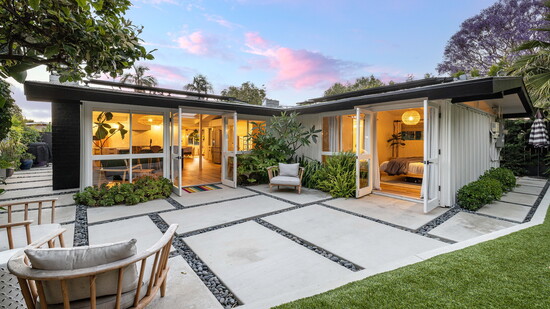Long Beach is a city with a rich architectural history showcasing architectural vernaculars from Gothic Revival to Mid-Century Modern and English Tudor. Here are five popular home styles you'll find throughout the city, along with their key characteristics and where to spot them.
Cliff May Rancho
Developed between 1953 and 1954 by designers Cliff May and Chris Choate in East Long Beach, these timeless gems feature low-slung gabled roofs, clerestory windows and exposed ceilings.
What distinguishes Cliff May Ranchos from other mid-century modern homes are their generous front yard setbacks, which allow for enhanced outdoor access and seamless indoor-outdoor living. These homes were specifically designed to take advantage of California's amazing weather, creating spaces that blur the boundaries between interior and exterior environments.
Coastal Contemporary
This style becomes increasingly abundant as you approach Long Beach's coastline. Modern architecture, in broad terms, means lacking ornament, so for these contemporary homes, striking the right balance between dynamism and good proportions becomes especially important. Coastal Contemporary homes are deeply defined by their natural material palettes and sophisticated neutral tones that complement the seaside environment.
English Tudor Revival
English Tudor homes are commonly identified by their exposed wooden beams filled with stucco or elaborate brick and stonework, all unified by steeply pitched gable rooflines. Because of Long Beach's mild climate, there has never been a practical reason for homes to have steep rooflines — which is precisely what makes these homes so charming.
They stand out in a sea of modern facades and clean lines, transporting you to a pastoral countryside despite their suburban surroundings. Their rich interior woodwork and emphasis on the hearth create elements of rusticity and wonder that feel both timeless and welcoming.
Spanish Colonial Revival
Popularized in the United States from 1910 to 1930, this style ranks among the most versatile architectural vernaculars. The exterior is defined by iconic features such as barrel clay roof tiles, hand-troweled stucco and graceful cased archways. This style developed in tandem with the Craftsman and Streamline Moderne movements, creating fascinating hybrid characteristics.
It's common to find Art Deco bathrooms with intricately tiled showers dating back 100 years, boasting tremendous personality. You'll also discover light fixtures commonly associated with Craftsman homes fitting seamlessly into Spanish bungalows. The use of wood and earth tones in permanent elements provides handsome backdrops suitable for restyling as trends evolve.
Craftsman
Born from the Arts & Crafts Movement in opposition to the Industrial Revolution, Craftsman-style homes emphasized the value of nature and handcrafted goods. The movement's embrace of imperfections and natural materials can be interpreted as a rejection of the dominant Streamline Moderne styles that emphasized machine-cut precision.
Architects Greene and Greene, pioneers of the Craftsman house movement, were proponents of the design philosophy known as Wabi-Sabi — balancing perfection with natural flaws. Steep overhanging eaves on low-pitched gables created an earthy feel, while deep front porches and abundant built-ins provided backdrops that supported thriving families and communities. Long Beach's Craftsman Village stands as a shining example of what thoughtful design can accomplish for society.
